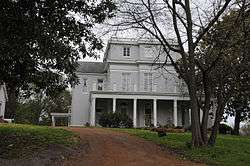James Erwin Caldwell
James Erwin Caldwell (September 18, 1854 – September 26, 1944) was an American businessman and banker from Tennessee. He served as the President of the Cumberland Telephone & Telegraph Company, later taken over by Southern Bell Telephone and Telegraph Company (now part of AT&T), which installed telephones across the Southern United States.
James Erwin Caldwell | |
|---|---|
| Born | September 18, 1854 Memphis, Tennessee, U.S. |
| Died | September 26, 1944 (aged 90) Nashville, Tennessee, U.S. |
| Resting place | Mount Olivet Cemetery |
| Occupation | Businessman, banker |
| Spouse(s) | May Winston |
| Children | Rogers Caldwell |
Early life
James Erwin Caldwell was born on September 18, 1854 in Memphis, Tennessee.
Career
Caldwell acquired a controlling interested in the Cumberland Telephone and Telegraph Company in 1890.[1] The firm installed telephones in Tennessee, Kentucky, Mississippi, Louisiana, as well as Southern Illinois and Indiana.[1] By 1912, its capitalization was US$20,000,000.[1] Caldwell served as its President until 1912,[1] when he became its Chairman.[2] That same year, it merged with the Southern Bell Telephone and Telegraph Company, and Caldwell served as its President.[1]
Caldwell was a large shareholder of the Fourth National Bank.[3] When it merged with the Third National Bank of St. Louis in 1912, he became President of the First and Fourth National Bank of Nashville.[3] The new bank was headquartered in The Stahlman in Downtown Nashville.[3] The bank merged with the American National Bank in 1930.[1] He retired shortly after.[1] However, by 1932, Caldwell was sued for fraud regarding the sale of shares during the merger.[4]
Caldwell was a major shareholder of the Rodessa Oil and Land Co.[5] In 1937, he was ordered by the chancery court to surrender his stock to cover some of his son Rogers's debt to the State of Tennessee.[5]
Caldwell recommended John Trotwood Moore for State Librarian and Archivist of Tennessee to Governor Albert H. Roberts in 1919.[6]
Personal life

Caldwell married May Winston. They resided at Longview, an antebellum mansion in Nashville, now owned by Lipscomb University. They had several children, including Rogers Caldwell, known as the "J.P. Morgan of the South."
Death
Caldwell died on September 26, 1944 in Nashville, Tennessee. He was buried at the Mount Olivet Cemetery.
References
- "James Caldwell Succumbs At Nashville Home". The Kingsport Times. Kingsport, Tennessee. September 26, 1944. p. 1. Retrieved October 1, 2015 – via Newspapers.com.

- "Officers Elected By C. T. & T. Directors: W. T. Gentry, President; James E. Caldwell, Chairman of Board. No Change in Location". The Tennessean. Nashville, Tennessee. February 3, 1912. p. 16. Retrieved October 1, 2015 – via Newspapers.com.

- "Directors Fourth and First Nat'l Banks Vote Merger: Stockholders Will Follow Suit at Meeting on July 9. Big Institution: F. O. Watts, Chairman of Board of Directors--James E. Caldwell, President--First to Move". The Tennessean. Nashville, Tennessee. June 25, 1912. p. 1. Retrieved October 1, 2015 – via Newspapers.com.

- "Fraud Is Charged In Bank Business: James E. Caldwell Is Named As Defendant In Chancery Bill At Nashville". The Tennessean. Nashville, Tennessee. March 17, 1932. p. 1. Retrieved October 1, 2015 – via Newspapers.com.

- "Chancellor Says Three Men Must Yield Oil Stock: Stock Bought For $100 Is Now Worth Million After Oil Is Discovered". The Kingsport Times. Kingsport, Tennessee. April 12, 1937. pp. 1, 8. Retrieved October 1, 2015 – via Newspapers.com.

- Bailey, Fred Arthur (Spring 1999). "JOHN TROTWOOD MOORE AND THE PATRICIAN CULT OF THE NEW SOUTH". Tennessee Historical Quarterly. 58 (1): 22. JSTOR 42627447.